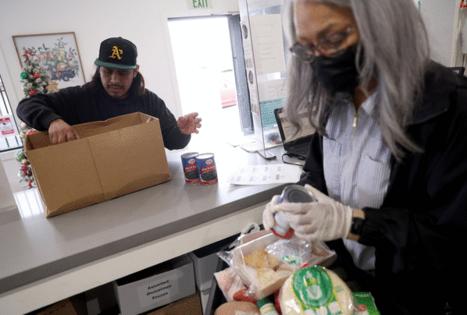SNAP food benefits have resumed, but new work requirements could push millions off assistance in California
Published in Business News
Food banks are scrambling to keep up with a continued surge in demand as Bay Area families are still recovering from lapses in federal food benefits triggered by the government shutdown.
The need could grow even greater as millions nationwide stand to lose benefits once new work requirements kick in next month. Grocery prices, meanwhile, are still rising, adding to the strain on many lower-income households.
“I’m struggling — I’ve got three boys,” said Luis Barragan, while waiting in line outside a busy food pantry in East Oakland. Barragan, 37, said he’s yet to receive his food benefits this month and has had to cut back on groceries.
Heading into Thanksgiving, hunger relief groups are rushing to fill gaps left by disruptions to the Supplemental Nutrition Assistance Program, at a time when they would normally be focused on planning their annual holiday food drives.
“We’re almost serving the same number of people as during the pandemic. We just have a lot fewer resources than we had then,” said Leslie Bacho, executive director of Second Harvest of Silicon Valley. The nonprofit serves around 500,000 people each month in Santa Clara and San Mateo counties.
In recent weeks, Second Harvest tallied a 300% increase in visits to its online portal for finding food distribution sites. Even after SNAP benefits resumed earlier this month, the number of people seeking aid remains well above what’s expected for this time of year, Bacho and officials at other food banks said.
During the shutdown, Trump administration officials paused benefits for the 42 million Americans — about 1 in 8 — who receive federal food aid. In the Bay Area, more than 682,000 residents, or 9%, rely on SNAP.
With the 43-day shutdown over, most SNAP recipients are now receiving their November payments, which in California average $332 per household. Next month’s disbursements are expected to arrive without issue, state officials said.
But expanded work requirements enacted by President Donald Trump’s “One Big Beautiful Bill” are set to start next month, raising fears that low-income households across the country soon could lose assistance. According to the nonpartisan Congressional Budget Office, the average monthly number of SNAP recipients is estimated to drop about 2.4 million over the next decade.
“That’s something we’re bracing for,” said Michael Altfest, community engagement director at the Alameda County Community Food Bank, adding the shutdown “gave us a little bit of a sign of what’s to come.”
Already, many low-income people enrolled in SNAP are required to work, volunteer or be in school or a job-training program. The rules had applied only to recipients aged 18 to 54 without a physical or mental disability and who don’t have dependents.
The new law extends the requirements to healthy recipients aged 55 to 64 and to adults with children aged 14 or older. An able-bodied recipient generally must work or participate in school or job training for an average of 20 hours each week. Those who don’t meet the work mandates can only collect benefits for three months out of every three years.
The law also repeals work exemptions for homeless people, veterans, and young adults exiting foster care, and limits states’ ability to waive the time limits on assistance for recipients in areas with few jobs.
The California Department of Social Services, which administers SNAP benefits through the CalFresh program, did not share how it may respond to a rush of residents losing assistance, but said state officials remain “committed to ensuring vulnerable Californians have access to the food support they need to the greatest extent possible.”
The law’s Republican supporters contend the changes will save taxpayer dollars by eliminating fraud and ensuring that only those who absolutely need benefits receive them.
Lance Christensen, vice president of government affairs for the California Policy Center, a conservative think tank, argued the SNAP program has created a strong disincentive for many to seek out work.
“They realize that if they make too much money, they’ll lose benefits and the funding that will be there for them will simply not be there anymore,” he said.
An analysis by the U.S. Census Bureau found that in 2018, more than three-quarters of families receiving SNAP had at least one person working, and about one-third had two or more workers. Around 39% of SNAP participants are children, 20% are elderly and 10% are nonelderly people with a disability, according to the U.S. Department of Agriculture.
For Barragan, the father from Oakland, what he earns working the night shift at a grocery warehouse is barely enough to pay for the $1,300 rent for his studio apartment and meals for his three sons, ages 7, 9 and 11.
With his $350 SNAP payment still pending this month, Barragan made sure to arrive on time at the food pantry after his shift ended at a warehouse in San Francisco. He picked up a bag of pears, four boxes of macaroni and cheese, a large red bell pepper and frozen vegetable samosas, along with other items to prepare for his sons.
Barragan said he’s unsure how he’ll be able to afford to feed his family if his benefits don’t arrive soon. “Now, everything is so expensive,” he said.
Food prices, which surged in the wake of the COVID-19 pandemic, have kept climbing this year amid new tariffs on imported goods, rising about 3% nationwide during the 12 months ending in September, according to federal data. Since the onset of the pandemic in March 2020, U.S. food prices have soared by about 30%.
While SNAP benefits are adjusted for inflation, they do not reflect the varying cost of living across most states.
Bacho, with Second Harvest Silicon Valley, encouraged communities to make financial donations to local food banks to help their neighbors shoulder those costs.
While volunteers and donations are crucial during this time of year, she said hunger-relief groups are always eager for support after the holidays, especially this year, given the impending work requirements.
“The need exists all year round,” she said.
©#YR@ MediaNews Group, Inc. Visit at mercurynews.com. Distributed by Tribune Content Agency, LLC.












Comments